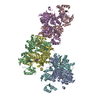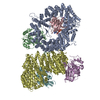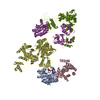[English] 日本語
 Yorodumi
Yorodumi- PDB-7pg3: Low resolution Cryo-EM structure of the full-length insulin recep... -
+ Open data
Open data
- Basic information
Basic information
| Entry | Database: PDB / ID: 7pg3 | ||||||
|---|---|---|---|---|---|---|---|
| Title | Low resolution Cryo-EM structure of the full-length insulin receptor bound to 3 insulin, conf 2 | ||||||
 Components Components |
| ||||||
 Keywords Keywords |  MEMBRANE PROTEIN / MEMBRANE PROTEIN /  Insulin / Receptor / Insulin / Receptor /  Complex Complex | ||||||
| Function / homology |  Function and homology information Function and homology informationregulation of female gonad development / positive regulation of meiotic cell cycle / positive regulation of developmental growth /  insulin-like growth factor II binding / male sex determination / exocrine pancreas development / insulin-like growth factor II binding / male sex determination / exocrine pancreas development /  insulin receptor complex / insulin receptor complex /  insulin-like growth factor I binding / insulin-like growth factor I binding /  insulin receptor activity / positive regulation of protein-containing complex disassembly ...regulation of female gonad development / positive regulation of meiotic cell cycle / positive regulation of developmental growth / insulin receptor activity / positive regulation of protein-containing complex disassembly ...regulation of female gonad development / positive regulation of meiotic cell cycle / positive regulation of developmental growth /  insulin-like growth factor II binding / male sex determination / exocrine pancreas development / insulin-like growth factor II binding / male sex determination / exocrine pancreas development /  insulin receptor complex / insulin receptor complex /  insulin-like growth factor I binding / insulin-like growth factor I binding /  insulin receptor activity / positive regulation of protein-containing complex disassembly / cargo receptor activity / insulin receptor activity / positive regulation of protein-containing complex disassembly / cargo receptor activity /  dendritic spine maintenance / dendritic spine maintenance /  insulin binding / insulin binding /  PTB domain binding / negative regulation of NAD(P)H oxidase activity / neuronal cell body membrane / adrenal gland development / negative regulation of glycogen catabolic process / regulation of cellular amino acid metabolic process / Signaling by Insulin receptor / IRS activation / nitric oxide-cGMP-mediated signaling / negative regulation of fatty acid metabolic process / Insulin processing / negative regulation of feeding behavior / PTB domain binding / negative regulation of NAD(P)H oxidase activity / neuronal cell body membrane / adrenal gland development / negative regulation of glycogen catabolic process / regulation of cellular amino acid metabolic process / Signaling by Insulin receptor / IRS activation / nitric oxide-cGMP-mediated signaling / negative regulation of fatty acid metabolic process / Insulin processing / negative regulation of feeding behavior /  regulation of protein secretion / amyloid-beta clearance / positive regulation of peptide hormone secretion / activation of protein kinase activity / regulation of protein secretion / amyloid-beta clearance / positive regulation of peptide hormone secretion / activation of protein kinase activity /  Regulation of gene expression in beta cells / positive regulation of respiratory burst / Regulation of gene expression in beta cells / positive regulation of respiratory burst /  regulation of embryonic development / positive regulation of receptor internalization / transport across blood-brain barrier / positive regulation of dendritic spine maintenance / alpha-beta T cell activation / negative regulation of acute inflammatory response / negative regulation of respiratory burst involved in inflammatory response / regulation of embryonic development / positive regulation of receptor internalization / transport across blood-brain barrier / positive regulation of dendritic spine maintenance / alpha-beta T cell activation / negative regulation of acute inflammatory response / negative regulation of respiratory burst involved in inflammatory response /  insulin receptor substrate binding / negative regulation of protein secretion / fatty acid homeostasis / Synthesis, secretion, and deacylation of Ghrelin / epidermis development / positive regulation of glycogen biosynthetic process / positive regulation of lipid biosynthetic process / Signal attenuation / FOXO-mediated transcription of oxidative stress, metabolic and neuronal genes / negative regulation of gluconeogenesis / positive regulation of nitric oxide mediated signal transduction / regulation of protein localization to plasma membrane / COPI-mediated anterograde transport / insulin receptor substrate binding / negative regulation of protein secretion / fatty acid homeostasis / Synthesis, secretion, and deacylation of Ghrelin / epidermis development / positive regulation of glycogen biosynthetic process / positive regulation of lipid biosynthetic process / Signal attenuation / FOXO-mediated transcription of oxidative stress, metabolic and neuronal genes / negative regulation of gluconeogenesis / positive regulation of nitric oxide mediated signal transduction / regulation of protein localization to plasma membrane / COPI-mediated anterograde transport /  phosphatidylinositol 3-kinase binding / negative regulation of lipid catabolic process / heart morphogenesis / negative regulation of oxidative stress-induced intrinsic apoptotic signaling pathway / positive regulation of insulin receptor signaling pathway / negative regulation of reactive oxygen species biosynthetic process / phosphatidylinositol 3-kinase binding / negative regulation of lipid catabolic process / heart morphogenesis / negative regulation of oxidative stress-induced intrinsic apoptotic signaling pathway / positive regulation of insulin receptor signaling pathway / negative regulation of reactive oxygen species biosynthetic process /  transport vesicle / positive regulation of protein autophosphorylation / dendrite membrane / Insulin receptor recycling / transport vesicle / positive regulation of protein autophosphorylation / dendrite membrane / Insulin receptor recycling /  insulin-like growth factor receptor binding / insulin-like growth factor receptor binding /  receptor-mediated endocytosis / NPAS4 regulates expression of target genes / positive regulation of protein metabolic process / neuron projection maintenance / endoplasmic reticulum-Golgi intermediate compartment membrane / positive regulation of brown fat cell differentiation / activation of protein kinase B activity / positive regulation of glycolytic process / Insulin receptor signalling cascade / positive regulation of mitotic nuclear division / receptor-mediated endocytosis / NPAS4 regulates expression of target genes / positive regulation of protein metabolic process / neuron projection maintenance / endoplasmic reticulum-Golgi intermediate compartment membrane / positive regulation of brown fat cell differentiation / activation of protein kinase B activity / positive regulation of glycolytic process / Insulin receptor signalling cascade / positive regulation of mitotic nuclear division /  learning / Regulation of insulin secretion / positive regulation of nitric-oxide synthase activity / positive regulation of long-term synaptic potentiation / learning / Regulation of insulin secretion / positive regulation of nitric-oxide synthase activity / positive regulation of long-term synaptic potentiation /  caveola / endosome lumen / positive regulation of cytokine production / acute-phase response / positive regulation of protein secretion / regulation of transmembrane transporter activity / positive regulation of cell differentiation / positive regulation of glucose import / negative regulation of proteolysis / caveola / endosome lumen / positive regulation of cytokine production / acute-phase response / positive regulation of protein secretion / regulation of transmembrane transporter activity / positive regulation of cell differentiation / positive regulation of glucose import / negative regulation of proteolysis /  regulation of synaptic plasticity / positive regulation of MAP kinase activity / regulation of synaptic plasticity / positive regulation of MAP kinase activity /  wound healing / wound healing /  insulin receptor binding / negative regulation of protein catabolic process / positive regulation of neuron projection development / insulin receptor binding / negative regulation of protein catabolic process / positive regulation of neuron projection development /  hormone activity / hormone activity /  receptor internalization / receptor internalization /  receptor protein-tyrosine kinase / receptor protein-tyrosine kinase /  memory / cellular response to growth factor stimulus / memory / cellular response to growth factor stimulus /  cognition / Golgi lumen / cognition / Golgi lumen /  vasodilation / positive regulation of protein localization to nucleus vasodilation / positive regulation of protein localization to nucleusSimilarity search - Function | ||||||
| Biological species |   Homo sapiens (human) Homo sapiens (human) | ||||||
| Method |  ELECTRON MICROSCOPY / ELECTRON MICROSCOPY /  single particle reconstruction / single particle reconstruction /  cryo EM / Resolution: 7.3 Å cryo EM / Resolution: 7.3 Å | ||||||
 Authors Authors | Nielsen, J.A. / Slaaby, R. / Boesen, T. / Hummelshoj, T. / Brandt, J. / Schluckebier, G. / Nissen, P. | ||||||
| Funding support |  Denmark, 1items Denmark, 1items
| ||||||
 Citation Citation |  Journal: J Mol Biol / Year: 2022 Journal: J Mol Biol / Year: 2022Title: Structural Investigations of Full-Length Insulin Receptor Dynamics and Signalling. Authors: Jeppe Nielsen / Jakob Brandt / Thomas Boesen / Tina Hummelshøj / Rita Slaaby / Gerd Schluckebier / Poul Nissen /  Abstract: Insulin regulates glucose homeostasis via binding and activation of the insulin receptor dimer at two distinct pairs of binding sites 1 and 2. Here, we present cryo-EM studies of full-length human ...Insulin regulates glucose homeostasis via binding and activation of the insulin receptor dimer at two distinct pairs of binding sites 1 and 2. Here, we present cryo-EM studies of full-length human insulin receptor (hIR) in an active state obtained at non-saturating, physiologically relevant insulin conditions. Insulin binds asymmetrically to the receptor under these conditions, occupying up to three of the four possible binding sites. Deletion analysis of the receptor together with site specific peptides and insulin analogs used in binding studies show that both sites 1 and 2 are required for high insulin affinity. We identify a homotypic interaction of the fibronectin type III domain (FnIII-3) of IR resulting in tight interaction of membrane proximal domains of the active, asymmetric receptor dimer. Our results show how insulin binding at two distinct types of sites disrupts the autoinhibited apo-IR dimer and stabilizes the active dimer. We propose an insulin binding and activation mechanism, which is sequential, exhibits negative cooperativity, and is based on asymmetry at physiological insulin concentrations with one to three insulin molecules activating IR. | ||||||
| History |
|
- Structure visualization
Structure visualization
| Movie |
 Movie viewer Movie viewer |
|---|---|
| Structure viewer | Molecule:  Molmil Molmil Jmol/JSmol Jmol/JSmol |
- Downloads & links
Downloads & links
- Download
Download
| PDBx/mmCIF format |  7pg3.cif.gz 7pg3.cif.gz | 334.4 KB | Display |  PDBx/mmCIF format PDBx/mmCIF format |
|---|---|---|---|---|
| PDB format |  pdb7pg3.ent.gz pdb7pg3.ent.gz | 266.1 KB | Display |  PDB format PDB format |
| PDBx/mmJSON format |  7pg3.json.gz 7pg3.json.gz | Tree view |  PDBx/mmJSON format PDBx/mmJSON format | |
| Others |  Other downloads Other downloads |
-Validation report
| Arichive directory |  https://data.pdbj.org/pub/pdb/validation_reports/pg/7pg3 https://data.pdbj.org/pub/pdb/validation_reports/pg/7pg3 ftp://data.pdbj.org/pub/pdb/validation_reports/pg/7pg3 ftp://data.pdbj.org/pub/pdb/validation_reports/pg/7pg3 | HTTPS FTP |
|---|
-Related structure data
| Related structure data |  13387MC  7pg0C  7pg2C  7pg4C M: map data used to model this data C: citing same article ( |
|---|---|
| Similar structure data |
- Links
Links
- Assembly
Assembly
| Deposited unit | 
|
|---|---|
| 1 |
|
- Components
Components
| #1: Protein | Mass: 156697.578 Da / Num. of mol.: 2 Source method: isolated from a genetically manipulated source Source: (gene. exp.)   Homo sapiens (human) / Gene: INSR / Production host: Homo sapiens (human) / Gene: INSR / Production host:   Cricetulus griseus (Chinese hamster) Cricetulus griseus (Chinese hamster)References: UniProt: P06213,  receptor protein-tyrosine kinase receptor protein-tyrosine kinase#2: Protein/peptide |  Mass: 2383.698 Da / Num. of mol.: 3 Source method: isolated from a genetically manipulated source Source: (gene. exp.)   Homo sapiens (human) / Gene: INS / Production host: Homo sapiens (human) / Gene: INS / Production host:   Saccharomyces cerevisiae (brewer's yeast) / References: UniProt: P01308 Saccharomyces cerevisiae (brewer's yeast) / References: UniProt: P01308#3: Protein/peptide |  Mass: 3433.953 Da / Num. of mol.: 3 Source method: isolated from a genetically manipulated source Source: (gene. exp.)   Homo sapiens (human) / Gene: INS / Production host: Homo sapiens (human) / Gene: INS / Production host:   Saccharomyces cerevisiae (brewer's yeast) / References: UniProt: P01308 Saccharomyces cerevisiae (brewer's yeast) / References: UniProt: P01308 |
|---|
-Experimental details
-Experiment
| Experiment | Method:  ELECTRON MICROSCOPY ELECTRON MICROSCOPY |
|---|---|
| EM experiment | Aggregation state: PARTICLE / 3D reconstruction method:  single particle reconstruction single particle reconstruction |
- Sample preparation
Sample preparation
| Component | Name: DDM solubilised full-length human insulin receptor with three insulins bound Type: COMPLEX / Entity ID: all / Source: RECOMBINANT | ||||||||||||||||||||
|---|---|---|---|---|---|---|---|---|---|---|---|---|---|---|---|---|---|---|---|---|---|
| Molecular weight | Value: 0.46 MDa / Experimental value: YES | ||||||||||||||||||||
| Source (natural) | Organism:   Homo sapiens (human) Homo sapiens (human) | ||||||||||||||||||||
| Source (recombinant) | Organism:   Cricetulus griseus (Chinese hamster) Cricetulus griseus (Chinese hamster) | ||||||||||||||||||||
| Buffer solution | pH: 7.8 | ||||||||||||||||||||
| Buffer component |
| ||||||||||||||||||||
| Specimen | Conc.: 4 mg/ml / Embedding applied: NO / Shadowing applied: NO / Staining applied : NO / Vitrification applied : NO / Vitrification applied : YES : YES | ||||||||||||||||||||
| Specimen support | Grid material: COPPER / Grid type: C-flat-2/2 | ||||||||||||||||||||
Vitrification | Instrument: LEICA EM GP / Cryogen name: ETHANE / Humidity: 100 % / Chamber temperature: 297 K / Details: Blotted for 3s prior to plunging |
- Electron microscopy imaging
Electron microscopy imaging
| Experimental equipment |  Model: Titan Krios / Image courtesy: FEI Company |
|---|---|
| Microscopy | Model: FEI TITAN KRIOS |
| Electron gun | Electron source : :  FIELD EMISSION GUN / Accelerating voltage: 300 kV / Illumination mode: FLOOD BEAM FIELD EMISSION GUN / Accelerating voltage: 300 kV / Illumination mode: FLOOD BEAM |
| Electron lens | Mode: BRIGHT FIELD Bright-field microscopy / Nominal defocus max: 2000 nm / Nominal defocus min: 500 nm Bright-field microscopy / Nominal defocus max: 2000 nm / Nominal defocus min: 500 nm |
| Image recording | Average exposure time: 15 sec. / Electron dose: 60 e/Å2 / Film or detector model: GATAN K2 SUMMIT (4k x 4k) |
- Processing
Processing
| EM software |
| |||||||||||||||
|---|---|---|---|---|---|---|---|---|---|---|---|---|---|---|---|---|
CTF correction | Type: PHASE FLIPPING AND AMPLITUDE CORRECTION | |||||||||||||||
3D reconstruction | Resolution: 7.3 Å / Resolution method: OTHER / Num. of particles: 32694 / Details: Masked FSC calculated with GSFSC in cryoSPARC2. / Symmetry type: POINT | |||||||||||||||
| Atomic model building | Protocol: FLEXIBLE FIT |
 Movie
Movie Controller
Controller













 PDBj
PDBj





















